Emerald Green Birthstone: History, Symbolism, and Care
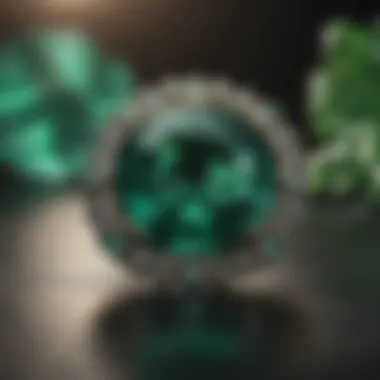
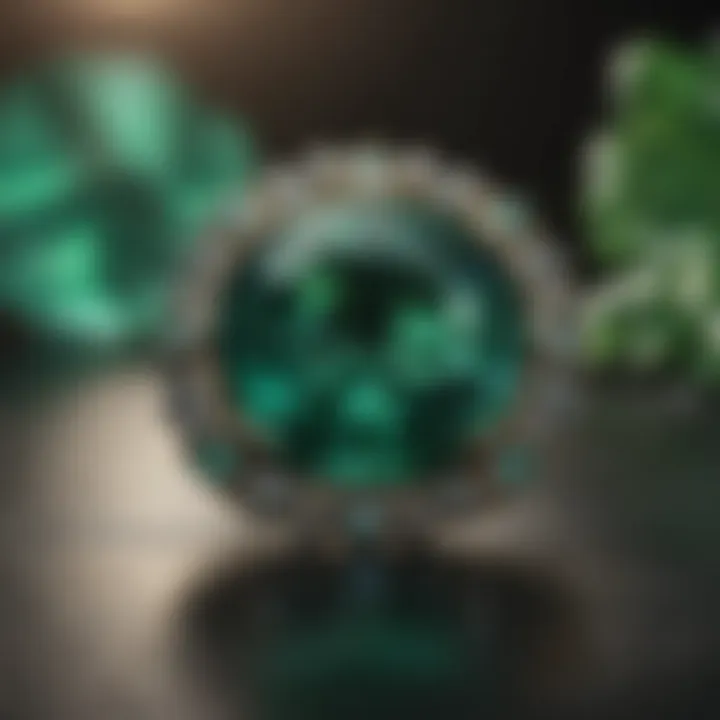
Intro
Emerald green is more than just a color; it embodies a rich history, cultural importance, and a stunning beauty that captivates the hearts of many. For gemstone enthusiasts and collectors, the emerald is not merely a gemstone; it’s an experience, a story etched in its vibrant hue. In this exploration, we will take a deep dive into all aspects of the emerald green birthstone, revealing what makes it so special and the reasons for its popularity across different cultures.
By dissecting the various elements of the emerald, including its origins, historical significance, composition, and care tips, readers will come away with an understanding far deeper than the color of the stone. This is not just a look at a pretty rock; it’s an encounter with a symbol of love, a driver of power, and a testimony to art in jewelry design.
Gemstone Overview
Definition and Origins
Emerald green refers specifically to a variety of the mineral beryl, which is treasured for its vivid green color, largely due to the presence of chromium. The name "emerald" comes from the Greek word "smaragdos," which means green stone. This stone has origins that trace back thousands of years, with records showing its use by ancient civilizations, including the Egyptians and Incas. The first known emeralds were mined in the region now known as Egypt, where Cleopatra famously owned an emerald mine, reinforcing the jewel's regal status in history.
Historical Significance
Throughout the ages, emeralds have been associated with many powerful figures and traditions. In ancient Rome, these stones were believed to bring good fortune and enhance intuition. For the Incas, emeralds symbolized fertility and rebirth. Many royal families, including the British monarchy, have adorned themselves with emeralds, highlighting their status and wealth.
Emeralds also carry associations with the heart, promoting love and compassion. The stone has been used in various cultures as a talisman, meant to protect the wearer from misfortune. As the popular saying goes, "The emerald is the gateway to the heart." Given its rich history, wearing an emerald is like wearing a piece of ancient history.
Gemstone Properties
Hardness and Durability
In terms of hardness, emeralds rate a 7.5 to 8 on the Mohs scale, which places them as relatively durable stones. Despite their beautiful appearance, they require care. They can be prone to chipping if not treated with caution. It’s essential to avoid sharp impacts or harsh chemicals when caring for these stones to maintain their luster over time.
Color and Clarity
The most distinctive aspect of emeralds is their mesmerizing color. The best quality emeralds are a rich, deep green, sometimes with a blue hue that appears almost ethereal. However, clarity can vary widely. Unlike many gemstones, emeralds often contain inclusions, also known as "jardin" — French for garden. These natural imperfections can add character, often enhancing the allure, but they may also affect value. While some collectors favor flawless stones, others appreciate the unique tales told through these inclusions.
"A true emerald has as much personality in its flaws as it does in its vibrant color."
Foreword to Emerald Green Birthstone
The emerald green birthstone stands as a luminary among gemstones, steeped in history and layered with meaning. It’s much more than just a pretty stone; it carries with it tales from ancient civilizations and is steeped in cultural import. For gemstone enthusiasts and collectors, understanding the essence of the emerald provides a pathway into its allure. In this section, we’ll explore its significance, not just as a jewel but as a symbol of growth, renewal, and more.
Emeralds, with their vivid green hue, are often associated with life and vigor. This makes them a perfect emblem for those born in May, as they mark a period of blossoming and fertility in nature. The stone’s lush coloration is reminiscent of spring, inviting thoughts of new beginnings. Collectors and designers appreciate this duality—the emerald is not just a decorative item, but a stone that tells a story and reflects the world around it.
Moreover, the emerald's importance emerges from its enduring presence across cultures. It has been revered by empires and civilizations from the time of the ancient Egyptians to today. Pharaohs adorned their tombs with emeralds, believing that the stone held protective qualities. This historical weight enhances its appeal, making it not just a coveted gem but a link to the past as well.
To further understand the emerald's role, consider its uses beyond mere ornamentation. It plays a significant part in metaphysical practices, believed by many to possess healing properties. It has been said that wearing this stone promotes balance and harmony, fostering peace of mind. People drawn to its vibrancy find that it can have a calming effect in tumultuous situations, making it a prized possession in both personal and professional realms.
In the subsequent sections, we will delve deeper into the emerald's historical significance, its role as a birthstone, and its unique physical properties. This exploration not only adds to our understanding of the emerald as a gemstone but also enriches our appreciation for its significance in the broader narrative of human civilization.
"Emeralds, more than a mere stone, embody a story of humanity's quest for beauty and meaning throughout time."
As we navigate through this journey, the emerald green birthstone continues to shine as a symbol of prosperity and hope. Its charm is irrefutable, inviting both admiration and introspection, urging us to appreciate the depth that a single gem can embody.
Historical Significance
The historical significance of emeralds is as rich and complex as their vibrant green hue. These gemstones have captivated humanity for centuries, serving not just as adornments but also as symbols of wealth, power, and spirituality. From ancient civilizations to modern society, emeralds have woven themselves into the very fabric of culture and tradition. Their importance is underscored by their association with various mystical beliefs and historical artifacts. Understanding this legacy sheds light on the timeless allure of emeralds and their stature in both history and contemporary contexts.
Origin of Emeralds
Emeralds are a member of the beryl family, characterized by a deep green color attributed to trace amounts of chromium and sometimes vanadium. The journey of emeralds began thousands of years ago, with historical records pointing to their extraction in ancient Egypt, where they were mined extensively around 330 BCE. These early emeralds were treasured by pharaohs and believed to bring protection and fertility. Cleopatra herself was known to have a profound fondness for these stones, leading to the establishment of the famous Cleopatra's Mines.
But the charm of emeralds isn’t confined to Egypt. Over the centuries, other notable mining locations emerged, including those in modern-day Colombia, which remains one of the most prominent sources today. Colombian emeralds are revered for their superior quality and depth of color, often fetching high prices among collectors. Additionally, emeralds have also been sourced from Afghanistan, Brazil, and Zambia, each location contributing unique characteristics to the stones mined there.
Cultural Reverence Through the Ages
Emeralds have transcended geographical boundaries and eras, earning reverence across numerous cultures. Their role in human history is akin to a timeless tapestry, woven with myths, legends, and beliefs. In the ancient world, emeralds were not just adornments; they held astrological significance. The Romans believed that emeralds could soothe the eyes and promote clarity of vision. They wore them to ward off negative energies and thereby enhance mental acuity.
In the Islamic tradition, emeralds were cherished and mentioned in the Quran, symbolizing paradise. The stone's association with tranquility and renewal has made it a favored choice in diverse spiritual practices across the globe. In Ancient Greece, it was linked to the goddess Venus, symbolizing love and rebirth. Moreover, many cultures see emeralds as a symbol of hope and fidelity, leading to their common use in engagement rings, where they serve as a declaration of lasting love.
Emeralds have a timeless appeal that resonates deeply across various traditions, manifesting as symbols of power, love, and renewal.
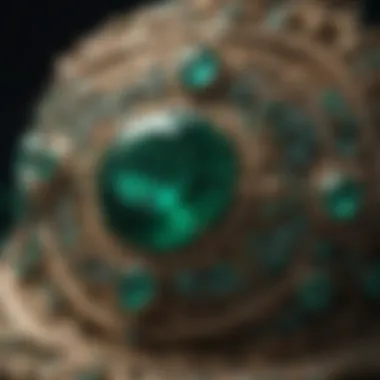
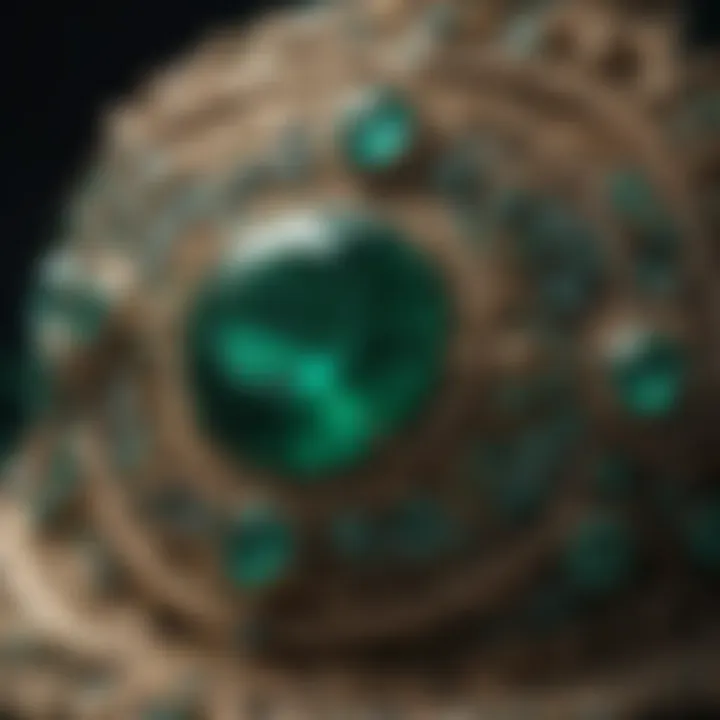
The significance of emeralds in culture can not be overstated. From the intricate carvings in ancient artifacts to their elegant settings in modern jewelry, these stones capture the essence of centuries. As traditions evolve, so do the meanings attributed to emeralds, but at their core lies the perennial understanding of their beauty and worth.
Emerald as a Birthstone
Emeralds hold a prominent position among birthstones, radiating not only beauty but also a depth of meaning and cultural significance. For those born in May, this vibrant green gemstone is far more than just a pretty accessory; it's a symbol of renewal, growth, and prosperity. As we delve into the notions surrounding emeralds as a birthstone, we unveil their connections to birth months, symbolism, and the implications these gems hold for individuals who embrace them. The appeal of emeralds isn't just skin-deep; their historical context and the characteristics associated with them enrich the lives of their wearers.
Associated Birth Months
Emerald is recognized as the birthstone for the month of May. This connection brings to life the ideals of spring—a time associated with blooming flowers and the rejuvenating energy that comes after the cold winter months. For individuals born in May, wearing an emerald can feel like wearing a piece of nature itself, encapsulating the spirit of revival.
Beyond the immediate personal connection, emeralds have also been historically linked with the astrological sign of Taurus, aligning themselves with characteristics such as determination and reliability. The stone’s lush green hue is often seen as a reflection of the vibrancy and optimism typically associated with this time of year.
Some cultures also view emeralds as symbols of luck, prosperity, and love, adding an extra layer to their significance for those born in May. This gemstone serves as a reminder of life's potential and the new beginnings that can arise with the freshness of spring.
Symbolism and Meanings
Emeralds are often steeped in a variety of symbolisms that span different cultures and eras. At its core, the emerald is celebrated for embodying growth, abundance, and healing. These associations can be traced back to ancient civilizations, where emeralds were believed to bring about balance and harmony in both personal and communal relationships.
The verdant color of emeralds conjures feelings of health and vigor, making them a favorite among those seeking inner peace and emotional stability. These gems are thought to help in cultivating compassion and collaboration. In fact, many believe that wearing an emerald can encourage a sense of rejuvenation and clarity in thought.
Furthermore, emeralds are intricately tied to themes of love and fidelity. In many traditions, they are regarded as the ultimate token of love, promising loyalty to partners and inspiring deep, lasting connections. For instance, it is rumored that Cleopatra cherished emeralds not just for their exquisite beauty but also for their association with the nurturing spirit of love.
Ultimately, the emerald serves not only as a lovely adornment but also as a powerful symbol, urging its wearers to embrace their true selves and to nurture their relationships.
Given this rich tapestry of meanings, it's clear why so many are drawn to this stunning stone. Whether you believe in its mystical properties or find delight in its lush appearance, the emerald carries a significance that resonates deeply with those who possess or admire it.
"Emeralds symbolize rebirth and love, offering a reminder to cherish the connections that enrich our lives."
In essence, the emerald's role as a birthstone transcends mere adornment; it interweaves stories of history, culture, symbolism, and emotion that echo through time.
Physical Properties of Emeralds
Understanding the physical properties of emeralds is crucial for anyone interested in this striking green gem. These properties not only define the emerald’s beauty and durability but also serve as key indicators of quality for collectors and jewelers alike. Whether you are a seasoned gem enthusiast or just beginning to appreciate the allure of emeralds, a solid grasp of these attributes is invaluable.
Emeralds are more than just a pretty face; their unique characteristics offer insight into their origins and value. Being aware of these properties can enhance your experience while purchasing, wearing, or even gifting emerald jewelry.
Chemical Composition
Emeralds belong to the beryl family, a group of minerals that share similar qualities. The basic component of emerald is beryllium aluminum silicate with the chemical formula Be3Al2Si6O18. What sets emeralds apart from other beryls is their striking green color, which primarily comes from trace amounts of chromium and vanadium.
The ratio of these elements can affect the depth and vibrancy of the green hue. As a result, you may find that certain emeralds have a more vivid or muted color based on their chemical makeup. When you look closely, some emeralds have a slight "play of color"—an occurrence where the gemstone seems to shimmer in different lighting conditions, thanks to its unique structure.
Formation and Mining Locations
Emeralds are often formed in metamorphic rocks, particularly within schist or gneiss, through a process that can take millions of years. They typically form in hydrothermal veins, where hot mineral-rich water seeps into cracks in the rocks. Over time, this water cools and evaporates, leading to the crystallization of emeralds.
Key mining locations that contribute to the globe’s supply of emeralds include:
- Colombia: Renowned for producing the highest quality emeralds rich in vibrant green color.
- Zambia: Known for its unique qualities, the Zambian emerald often shows a slightly bluish hue due to iron.
- Brazil: Produces a variety of emeralds, including lighter-colored stones with less saturation.
The geographical conditions of these mining locations, including factors like climate and pressure, play a significant role in the size and quality of the emeralds extracted. Each origin imparts different characteristics to the stones, making them unique in their own right.
Color Variations and Quality Assessment
The captivating green of emeralds can vary widely; from light, almost pastel greens to the deep, mesmerizing shades that catch the eye. This variation is primarily influenced by the mineral content and the conditions under which they formed.
Quality assessment typically hinges on factors such as:
- Color: The most important characteristic. A vivid, uniform green is often more desirable.
- Clarity: Emeralds naturally contain inclusions, often referred to as "jardin" (French for garden), which can enhance their character or impact their value depending on severity.
- Cut: The way an emerald is cut can significantly affect its appearance. Traditional cuts like the emerald cut maximize the color while minimizing apparent inclusions.
When evaluating emeralds, it’s essential to consider both visual appeal and these key characteristics, as they determine not just the beauty but also the value of the gemstone.
The intricate journey of emeralds, from their geological roots to their roles in jewelry, provides a deeper appreciation of their allure.
In summary, the physical properties of emeralds lend not only to their stunning appearance but also to their stories and values. Understanding these aspects will serve you well whether you’re collecting or simply admiring this lush green gemstone.
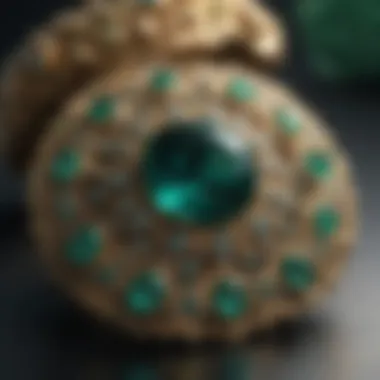
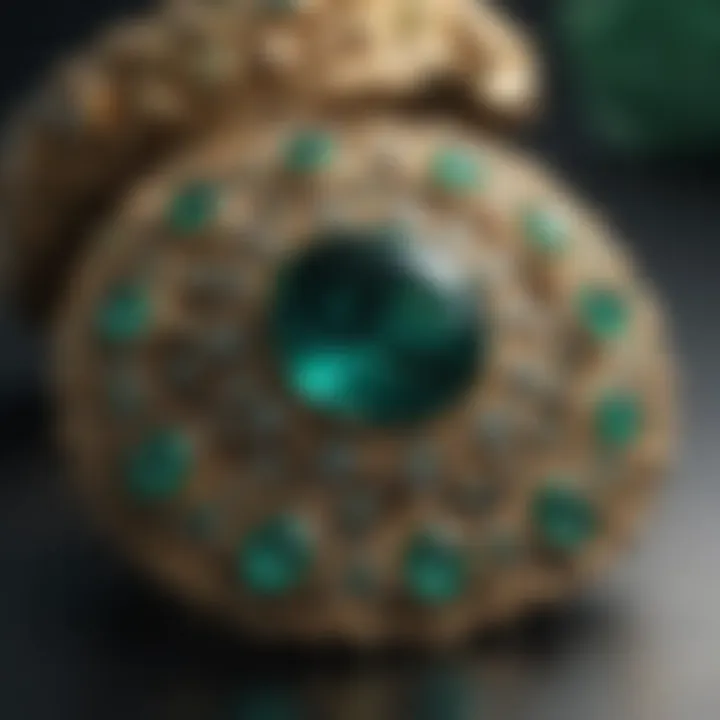
Metaphysical Properties
The realm of metaphysics engages with the unseen forces around us, often lending significance to subconscious impressions and emotional connections. When we speak about emerald green birthstone, its metaphysical properties garner particular attention. Many believe that emeralds, renowned for their luscious hue and clarity, encapsulate potent energies that resonate with both the physical and spiritual dimensions. This section will explore the healing attributes and emotional benefits associated with emeralds, providing insight into why these stones have captivated hearts across the ages.
Healing Attributes
Emeralds are often associated with healing across various traditions. Practitioners of crystal therapy assert that these gemstones can promote balance and harmony in the body. The deep green color is said to align with the heart chakra, fostering an environment that enhances not only physical health but also emotional stability. Here are some healing attributes often linked to emeralds:
- Aid in Recovery: Many assert that emeralds assist in the recovery from ailments, particularly those related to the heart and lungs. They are thought to help promote regeneration and renewal.
- Enhance Physical Energy: It is said that wearing emeralds can invigorate the physical body, reducing fatigue and boosting vitality. People often feel more energized when surrounded by its vibrant energy.
- Relieve Stress: Emerald’s calming essence is believed to temper stress, enabling clarity and focus in challenging situations. Keeping an emerald nearby is often recommended for those needing to navigate life's tumultuous waters.
"Emeralds are called the stones of intuition; they help one tap into the inner wisdom that lies just beneath the surface."
Their purported ability to reflect the natural world's beauty underscores their role as a healing ally. As one pours over its radiance, there’s a sense that the emerald invites calm and aligns the spirit.
Emotional Benefits
The emotional landscape often correlates with our physical experiences, and emeralds are credited with aiding this symbiosis. Many gemstone enthusiasts emphasize the profound emotional benefits tied to emeralds. Here are some insights:
- Fostering Compassion and Love: The emerald’s strong connection to the heart chakra is said to enhance feelings of love and compassion. This connection can lead to improved relationships, cultivating trust and understanding between individuals.
- Promoting Positivity: Individuals often report that emeralds can usher in a sense of renewal in times of despair. This gemstone is thought to diminish negative feelings and replace them with a sense of hope and positivity.
- Encouraging Self-Reflection: The clarity of emeralds allows for self-examination and critical thoughts that can lead to personal growth. Holding or wearing an emerald may encourage one to look inward and confront emotions, insecurities, or fears.
Ultimately, the intertwining metaphysical properties of emeralds suggest a bridge between inner and outer worlds, prompting one to pursue healing and emotional well-being. This harmonious balance may reveal much about the personal journeys of those who wear or cherish these stunning stones.
Emeralds in Jewelry
Emeralds have long held a prime spot in the world of jewelry, captivating the hearts of many with their lush green hue and unique charm. As a result, they are not just stones but symbols of luxury, creativity, and timeless elegance. The importance of emeralds in jewelry reflects not only their aesthetic appeal but also their rich historical and cultural significance, making them a favored choice among gemstone enthusiasts, collectors, and designers alike.
Integrating emeralds into various jewelry pieces can elevate their allure. Whether set in rings, necklaces, or earrings, the deep green color of emeralds provides a striking contrast against metals like gold and silver. This vibrant gemstone draws the eye and invites admiration, making it an essential element for anyone looking to make a statement in their jewelry collection.
Design Trends Featuring Emeralds
Emeralds have made waves recently in jewelry design, with trends that embrace both traditional and modern aesthetics. Here are a few notable trends:
- Vintage Revivals: Many jewelers are looking back to art deco and Victorian styles, where emeralds were often set in intricate and lavish designs. These pieces frequently feature detailed craftsmanship and combine emeralds with other gemstones for added glamour.
- Minimalistic Designs: On the opposite spectrum, there’s a growing preference for minimalistic styles. Simple bands featuring a single emerald stone can be understated yet incredibly chic, proving that sometimes less is more.
- Mixed Media: Jewelry that combines emeralds with unconventional materials, such as leather or acrylics, is gaining traction. This innovative approach speaks to a younger audience searching for unique expression in their adornments.
"The emergence of contemporary design with emeralds helps bridge the gap between tradition and modernity, appealing to a diverse demographic who value aesthetics."
Choosing the Right Setting
Selecting the right setting for an emerald is crucial, as it not only affects the stone's visibility but also its overall appeal. Here are essential factors to consider when choosing a setting:
- Setting Type:
- Metal Choice: The metal’s color can greatly influence the stone’s appearance. Yellow gold can warm the hue of the emerald, creating a classic look, while white gold or platinum may lend a modern edge.
- Style Compatibility: The setting should mirror the wearer's personal style—delicate for those who prefer subtlety, or bold for individuals wishing to stand out.
- Prong Settings: These hold the emerald securely while allowing maximum light to pass through, enhancing its color and brilliance.
- Bezel Settings: Ideal for those who lead an active lifestyle, bezel settings encase the emerald entirely, providing protection and a sleek look.
Caring for your emerald, regardless of its setting, remains vital to preserving its beauty. Following best practices in maintenance ensures your emerald jewelry retains its stunning allure for years to come.
Caring for Emeralds
Caring for emeralds is not just about maintaining their beauty; it's about preserving the stone’s intrinsic qualities and ensuring its longevity. These vibrant green gems, with their rich history and symbolic meanings, require thoughtful attention to keep them looking their best. Whether you are a seasoned collector or a novice jewelry wearer, understanding the right care practices can significantly enhance your experience with emeralds.
Emeralds are relatively soft stones on the Mohs scale, ranking between 7.5 and 8. This means they are more vulnerable to scratches and damage compared to harder gemstones like sapphires or diamonds. Consequently, understanding how to clean, store, and maintain these breathtaking stones is essential to avoid costly damage.
Cleaning Techniques
Cleaning emeralds requires a gentle touch. Here are effective cleaning methods to ensure your jewels shine:
- Soap and Water: The most straightforward method is to use a mixture of warm water and mild dish soap. Soak your emerald jewelry in the solution for a few minutes, then gently wipe it clean with a soft cloth. Avoid using brushes or anything abrasive, which could scratch the surface.
- Ultrasonic Cleaners: While these devices work wonders on many gemstones, caution should be taken with emeralds. It is usually advisable to steer clear of ultrasonic cleaners as they can loosen oil treatments in the stones, potentially causing damage.
- Avoid Chemical Cleaners: Strong chemicals can harm the emerald's surface and its internal structure. Bleach or ammonia-based cleaners should not find a place in your cleaning routine.
"The best approach is to treat your emeralds with the same care you would a delicate flower in bloom."
Storing and Maintenance Tips
Proper storage of emeralds is equally crucial to prevent unnecessary wear and tear. Here are some practical tips for storing your emerald jewelry:
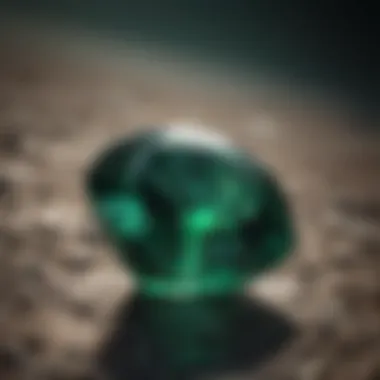
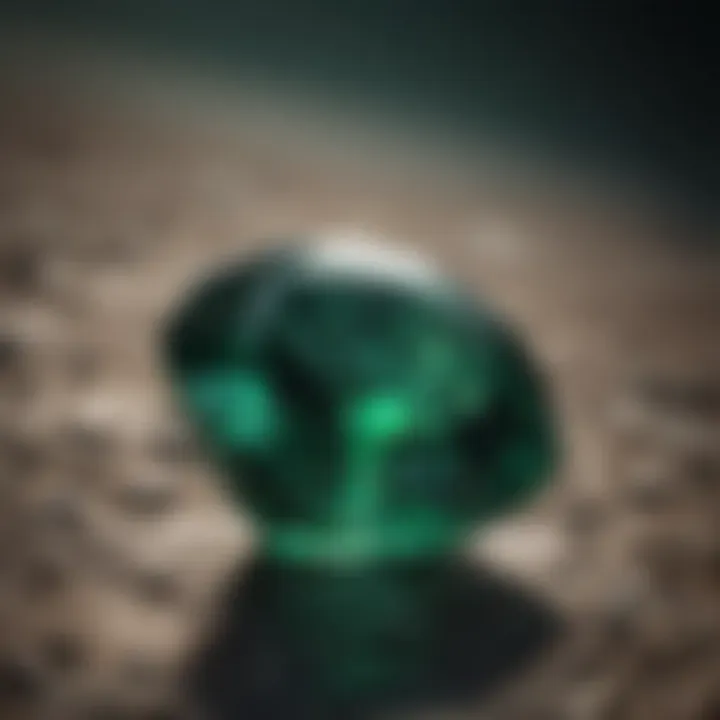
- Avoid Contact with Other Jewelry: Keep your emeralds in a separate compartment or lined jewelry box. This practice minimizes the risk of scratches from harder gemstones. Consider using a soft cloth or pouch to wrap each piece.
- Temperature and Humidity Control: Emeralds should be stored in a stable environment. Extreme temperature fluctuations and high humidity can lead to cracks or chips. Ideally, a drawer or box with a consistent climate is best.
- Regular Checks: Regularly inspect your emeralds for signs of damage or wear. If you notice anything unusual, consult a professional jeweler. They can provide necessary repairs and rejuvenate your emerald's appearance.
By implementing these cleaning techniques and storage precautions, you can ensure that your emerald jewelry remains radiant for years to come. Remember, taking the time to care for your stones not only enhances their beauty but also increases their sentimental and financial value.
Identifying Authentic Emeralds
Identifying authentic emeralds is crucial for both consumers and collectors alike. Given the resurgence in popularity of these gemstones, the market has seen a parallel rise in synthetic alternatives. Knowing how to differentiate between natural and synthetic emeralds not only protects buyers from potential fraud but also enhances their appreciation for this stunning birthstone.
Distinguishing Natural from Synthetic
Emeralds can either be natural, formed within the earth over millions of years, or synthetic, which are manufactured in laboratories. Here are some key points to understand the distinctions:
- Color and Clarity: Natural emeralds often exhibit inclusions and variations that are nearly impossible to recreate in lab-created stones. These inclusions, also known as the emerald’s "garden," are essential for authenticity. You might notice tiny fissures or even gas bubbles which reveal the stone's natural story.
- Light Reflection: When viewed under natural light, an authentic emerald gives off a unique sheen, often described as "glowing," while synthetic versions may appear overly perfect and exhibit a glass-like finish.
- Price Point: Generally, a natural emerald will carry a higher price tag due to its rarity. If a deal seems too good to be true, it often is. Familiarizing oneself with market prices can aid in making informed purchases.
Remember, a trained eye can decipher between the authentic and synthetic, but it’s wise to consult an expert gemologist when in doubt.
Certificates of Authenticity
To ensure you are purchasing a genuine emerald, seek out certificates of authenticity. A reputable seller should provide documentation from a recognized gemological laboratory that confirms the gemstone’s identity and quality. A certificate typically contains:
- Detailed Descriptions: This includes the stone's characteristics, such as its origin, treatments it may have undergone, and its unique inclusions.
- Identification Number: Each certificate carries a unique number, allowing traceability and verification.
- Professional Grading: The gemological report includes information such as color grading, clarity, cut, and carat weight, which all play vital roles in determining a stone's value.
"Always demand a certificate from major gemological labs - it's like a birth certificate for your gemstone. Without it, you might as well be buying a house without checking the title."
In summary, being vigilant while identifying authentic emeralds is essential. Knowledge about distinguishing natural from synthetic stones paired with validated certificates can ensure that your investment in emeralds is sound, preserving both their aesthetic and economic value. Familiarity with these key elements not only empowers buyers but also deepens a passion for this enchanting gemstone.
Emerald Green in Popular Culture
The emerald green gemstone has made its mark not just on the jewelry scene but also in literature and the arts. Beyond its captivating beauty, its presence in various cultures paints a picture of deep-seated meanings and inspirations. This cultural essence not only contributes to the allure of the emerald but also enhances its desirability among collectors and enthusiasts.
Emeralds in Literature and Art
Emeralds have been a symbol of wealth, wisdom, and beauty throughout time. In literature, authors have often used the stone as a metaphor or symbolism. For instance, in Shakespeare's A Midsummer Night's Dream, emeralds are mentioned alongside other precious stones, signifying their value and rarity. The lush green color often reflects nature and life, capturing the imagination of writers and artists alike.
Artists from different periods have embraced emeralds to convey emotion and narrative. For example, the Renaissance painters used vibrant green hues, reminiscent of emeralds, to create depth and emotion in their work. Think of the emerald green robes in paintings, symbolizing both authority and the divine.
Moreover, the gemstone has been a muse for poets and storytellers, representing hope, rebirth, and new beginnings. Many fairy tales and folklore traditions associate emeralds with enchanted lands, love stories, and thrones of power, blending fantasy and reality. This intersection of nature and imagination enriches the emerald's history, making it a significant cultural icon.
Celebrities and Their Emerald Jewelry
The allure of emeralds extends into modern-day celebrity culture. Numerous A-list stars have been spotted flaunting emerald jewelry at red carpet events, creating a buzz around the gemstone. Notable figures like Angelina Jolie and Beyoncé have often chosen to wear emeralds, not just for their aesthetics but as a statement piece. Their choices illuminate how the gemstone resonates with luxury and style.
Emerald earrings, necklaces, and rings are not just accessories; they tell stories. When worn by celebrities at significant events, they signify both personal milestones and cultural heritage. For instance, when Michelle Obama wore a stunning emerald necklace during a state dinner, it was representation of both elegance and a nod to her roots, bringing a deeper connection to the piece.
In addition, emeralds have played a role in red carpet ambiance, drawing attention to the importance of choice in expressing individuality and taste. Ditto for famous fashion designers who often feature emeralds in their collections, showing how these stones can transform even the simplest outfits into something breathtaking.
Emeralds in popular culture serve as a bridge between historical significance and contemporary allure, creating a tapestry of interwoven narratives that enrich our understanding of this magnificent gemstone.
The influence of emeralds in literature and by celebrities highlights their significance beyond mere adornments, making them powerful symbols within broader cultural dialogues.
Epilogue
The conclusion of this article serves as a vital recap and reflection on the multifaceted nature of the emerald green birthstone. Understanding its various dimensions not only enriches our appreciation for this captivating gem but also underscores its significance in our lives. Emphasizing key aspects such as its historical roots, unique physical properties, and profound metaphysical associations creates a rounded narrative that appeals to diverse interests.
Significance of the Emerald Green Birthstone
In summary, the emerald stands alone as a gemstone with deep cultural and historical resonances. From its ancient associations with royalty to its contemporary appeal in fine jewelry, the emerald's journey through time highlights its lasting importance. For those with a penchant for collecting or simply appreciating gemstones, the emerald is much more than a pretty stone; it embodies timeless elegance and a rich tapestry of stories.
Benefits of Understanding Its Properties
Recognizing the physical properties of emeralds, such as their unique coloration and the aspects of quality assessment, can significantly impact purchasing decisions. Knowledge empowers enthusiasts and collectors to make informed choices, avoiding common pitfalls associated with less-than-honest sellers. Knowledge of how to properly care for emeralds preserves their beauty, ensuring that they can be cherished for generations.
Additionally, understanding the metaphysical attributes of emeralds can enhance one’s commitment to their personal and spiritual well-being. Many believe that this vibrant stone fosters love, balance, and harmony. By integrating these ideas into daily life, individuals might find themselves not just owning a gemstone, but also harnessing its energy.
Awareness and Authenticity
The importance of authenticity in the realm of emeralds cannot be overstated. Knowing how to differentiate between natural and synthetic emeralds allows collectors to guard against potential deceit. Choosing gemstones with certifications ensures that the investment made is indeed just that—an investment.
Emeralds have a unique presence in popular culture, whether in literature, art, or celebrity endorsements, which adds another layer of fascination. The stories interwoven into the fabric of the emerald's existence provide context and insight that entertain as well as inform.



